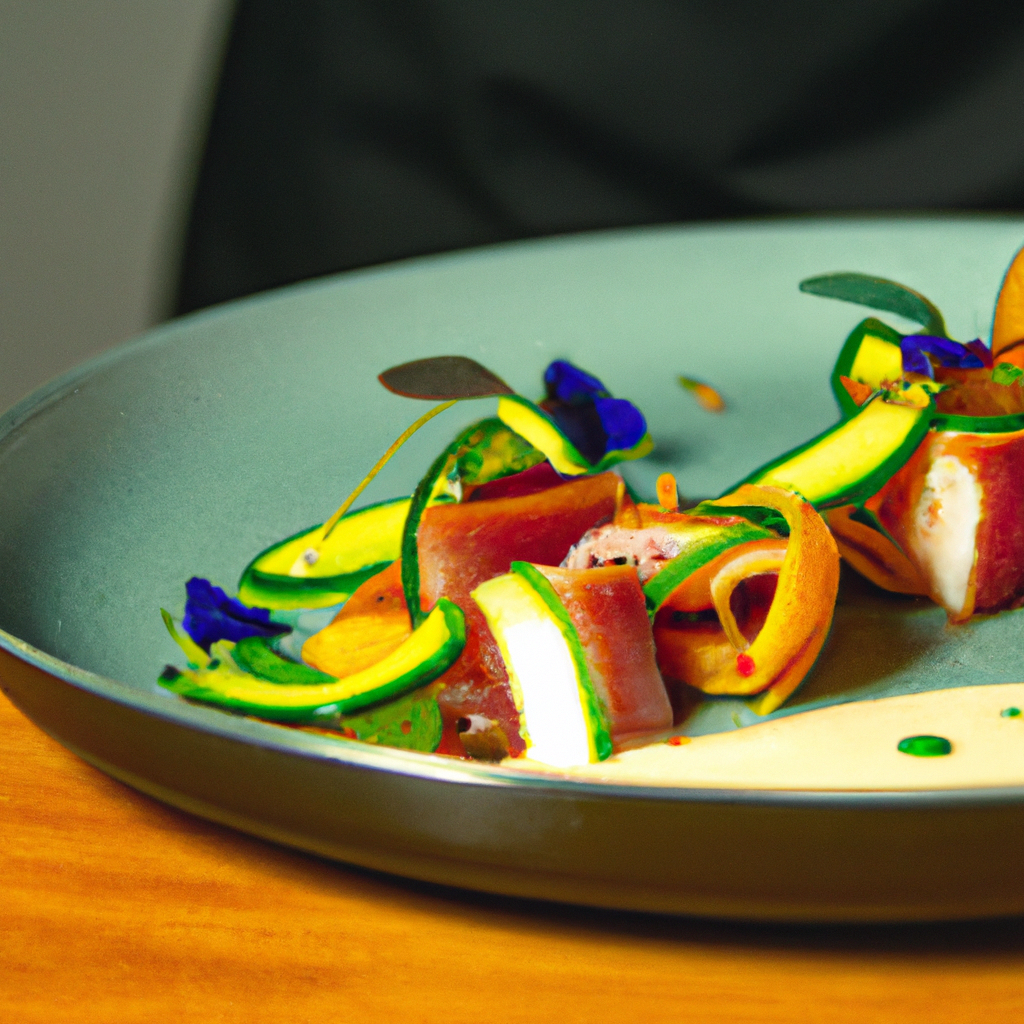In the realm of culinary artistry, taste is king. A harmonious blend of flavors, textures, and aromas can transport us to a world of gratification like no other. Yet, amidst this enchanting gastronomic journey, we often underestimate the significance of another key player – the presentation. Enter the captivating world of “The Art of Plating,” where culinary mastery meets visual finesse. Beyond the mere act of arranging food on a plate, the art of plating transcends boundaries, elevating our dining experience to an elevated realm where every dish becomes a masterpiece. So, fasten your seat belts and prepare to embark on a tantalizing voyage that will unveil the secrets to creating culinary presentations that ignite not only our taste buds but also our visual senses.
1. “Crafting Culinary Masterpieces: The Art of Plating Unveiled”
Embark on a gastronomic journey as we explore the intricate world of plating, where food becomes art. In this section, we will dive into the secrets, techniques, and inspirations behind crafting culinary masterpieces that not only tantalize the taste buds but also captivate the eyes.
Plating is an essential aspect of a chef’s repertoire, transforming a dish from mere sustenance into a visual masterpiece. Just like a painter with a canvas, a chef carefully selects the perfect palette of colors, textures, and shapes to create a plate that tells a story and evokes emotions.
Let your imagination soar as we unveil the art of plating and expose the tricks of the trade that have been honed over centuries. Discover how chefs combine elements such as height, symmetry, and contrast to create stunning visual compositions that elevate the dining experience to new heights.
Delve into the world of edible garnishes, where herbs, microgreens, and edible flowers are meticulously placed to add vibrancy, freshness, and an extra touch of elegance to a dish. Learn how these small, delicate additions can elevate a plate from ordinary to extraordinary.
Uncover the secrets of the perfect sauce drizzle, as we explore how chefs use squeeze bottles, spoons, and artistic flair to add precision and finesse to each stroke. Witness how even the subtlest stroke of a brush can transform a plate into a true work of art.
Step into the shoes of a chef and dive into the world of plating techniques such as the classic radial plating, the modern minimalistic style, or the whimsical asymmetrical design. Find out how each approach can evoke different emotions and create distinct dining experiences.
Join us on this mesmerizing culinary journey as we unravel the mystique behind the art of plating. Prepare to be inspired, astonished, and ultimately, motivated to embark on your own creative exploration in the world of culinary art.
2. “Beyond Taste: Unleashing the Aesthetics of Culinary Presentation”
In the world of culinary arts, taste has always been considered the ultimate judge of a dish’s success. However, there is another factor that has the power to elevate gastronomy to new heights – the aesthetics of culinary presentation. The way a dish is visually presented can engage our senses in unexpected ways, making the experience of dining truly exceptional.
Culinary presentation goes far beyond simply arranging food on a plate. It is an art form that requires creativity, precision, and attention to detail. Chefs around the world are pushing the boundaries of what is possible, turning their plates into canvases and their ingredients into vibrant colors and textures.
One of the key principles of culinary presentation is balance. The arrangement of different elements on a plate should create a harmonious composition, where each component complements and enhances the overall visual appeal. Chefs often use contrasting colors, shapes, and textures to create a stunning visual impact. For example, a vibrant green puree can be paired with a light and delicate protein for a visually striking combination.
Furthermore, chefs are now incorporating artistic techniques and tools into their culinary presentation. From tweezers and brushes to edible flowers and microgreens, each element is strategically placed to create a visually captivating experience. The use of sauces and negative space on the plate also adds to the overall aesthetics, enhancing the visual appeal and adding depth to the dish.
Ultimately, culinary presentation is an integral part of the dining experience. It allows chefs to express their creativity and engage diners in a multisensory journey. The aesthetics of culinary presentation not only elevate the enjoyment of the food itself but also create a lasting impression that lingers in the memory of those fortunate enough to experience it.
3. “From Palette to Plate: Elevating Your Cuisine Through Artful Plating”
Transforming a dish into a work of art is an integral part of fine dining. While taste is undoubtedly important, presentation is what captures the eyes first. Artful plating takes your culinary creations to new heights, captivating diners before they even take the first bite.
Embracing artistic plating techniques allows you to showcase your culinary skills and express your creativity on the plate. Here are some tips to elevate your cuisine through artful plating:
- Play with colors and textures: Use vibrant and contrasting colors to create visual appeal. Incorporate a variety of textures, from creamy to crunchy, to add depth and interest to the dish.
- Consider the plate as a canvas: Treat your plate like an artist’s canvas, using different areas to create focal points. Utilize negative space to create balance and give your food room to breathe.
- Use edible garnishes: Enhance your dish with edible garnishes like microgreens, herbs, or edible flowers. They not only add a pop of color but also provide additional layers of flavor.
- Experiment with different plating styles: Explore different plating styles such as layering, stacking, or arranging food in a geometric pattern. Each style can bring a unique visual impact to your dish.
The art of plating is not limited to high-end restaurants or professional chefs. With a little practice and experimenting, anyone can elevate their home-cooked meals into visually stunning masterpieces. Remember, the plate is your blank canvas, so allow your imagination to guide you and let your culinary skills shine through artful plating.
4. “Designing Delight: Unveiling the Secrets Behind Stunning Culinary Presentations
“
Picture this: a plate that looks more like a piece of art than a meal. Vibrant colors, intricate designs, and carefully arranged ingredients that instantly captivate your senses. How do chefs create these stunning culinary presentations that leave us in awe? It’s time to unravel the mysteries and explore the secrets behind these works of edible beauty.
1. Attention to detail: The key to any visually appealing culinary presentation lies in the meticulous attention to detail. From the placement of each ingredient to the visual harmony of the dish, every element is carefully considered. Chefs pay close attention to color contrasts, textures, and the overall composition of the plate to create a visually stunning masterpiece.
2. Play with height and texture: A visually enticing culinary presentation often incorporates height and texture, adding another layer of interest and intrigue to the dish. Chefs may use edible props like delicate microgreens or edible flowers to add height and dimension to their creations. Additionally, contrasting textures, such as a crispy garnish atop a creamy puree, can create a delightful sensory experience for the diner.
3. Colors that pop: Just like a painter expertly selects colors to create a masterpiece, chefs carefully choose ingredients that bring vibrancy and life to their dishes. A splash of vibrant red tomatoes against a backdrop of vibrant greens or a drizzle of bright yellow sauce can transform a boring plate into a feast for the eyes.
4. Symmetry and balance: Achieving visual harmony is crucial in culinary presentations. Chefs often use symmetrical plating techniques to create a sense of balance and order on the plate. This not only pleases the eye but also enhances the overall dining experience, making the dish feel more intentional and thoughtfully prepared.
5. Surprise elements: True culinary artists know the value of surprise and playfulness in their presentations. An unexpected ingredient, an imaginative shape, or a whimsical garnish can bring an element of surprise and delight to the diner. These unexpected additions add an element of excitement and make the dining experience truly memorable.
Embark on a journey behind the scenes and uncover the secrets chefs use to create those stunning culinary presentations. While it may seem like magic, it’s the combination of attention to detail, creative thinking, and a passion for the art that makes these dishes not only pleasing to the palate but also a feast for the eyes.
From plating colorful ingredients in a single line to strategically placed dots of condiments and sauces, the art of plating can be an inspiring way to elevate a dish and make it look like a work of art. Take time to practice and hone the craft and you will be sure to plate like a professional chef in no time!


